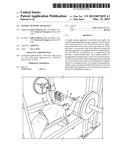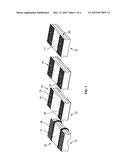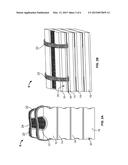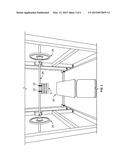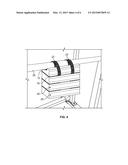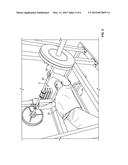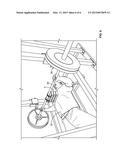Patent application title: Weight Training Apparatus
Inventors:
John P. Dalessio (New Providence, NJ, US)
Donovan Thompson (Denver, NC, US)
IPC8 Class: AA63B21078FI
USPC Class:
482104
Class name: Utilizing weight resistance including stationary support for weight barbell support
Publication date: 2015-03-12
Patent application number: 20150072839
Abstract:
A weight training apparatus is described and taught. The weight training
apparatus having a number of blocks preferably constructed out of wood.
These blocks have an attachment mechanism such as a hook and loop
fastener to adhere the blocks to one another. One of the blocks has
straps that secure the apparatus to a weighted barbell for weight
training. The user then lies, on their back, on a weight bench, and
performs a typical bench press. The weighted barbell is brought down
towards the user's chest in a controlled motion. The bottom block of the
weight training apparatus touches the user's chest and the user exerts a
force returning the weighted barbell to its original position. The weight
training apparatus enables a user to perform modified bench presses to an
exact depth without the requirement of a second person. It may also be
used for rehabilitation purposes.Claims:
1. A weight training apparatus comprising: one coupling block having a
semi-circular groove, at least one securement strap, and an attachment
mechanism disposed on a lower surface of the one coupling block; a
plurality of intermediate blocks having the attachment mechanism disposed
on an upper surface and a lower surface of the plurality of intermediate
blocks; and one base block having the attachment mechanism disposed on an
upper surface of the one base block.
2. The weight training apparatus of claim 1 wherein the attachment mechanism is a hook and loop fastener.
3. The weight training apparatus of claim 1 wherein the semi-circular groove is padded.
4. The weight training apparatus of claim 1 further comprising a hand grip.
5. The weight training apparatus of claim 4 wherein the hand grip is a groove on each lengthwise vertical face.
6. The weight training apparatus of claim 5 wherein the groove on the lengthwise vertical faces aids in separating the blocks from one another.
7. The weight training apparatus of claim 1 wherein the at least one securement strap employs a hook and loop fastener.
8. The weight training apparatus of claim 7 wherein there are two securement straps.
9. The weight training apparatus of claim 2 wherein the hook fastener is on the lower surface of the blocks and the looped fastener is on the upper surface of the blocks.
10. The weight training apparatus of claim 3 wherein the semi-circular groove has a diameter such that it adapts to a barbell.
11. A weight training apparatus comprising: a coupling block having a groove, at least one securement strap, and an attachment mechanism disposed on a lower surface of the coupling block; at least one intermediate block having an attachment mechanism disposed on an upper surface and a lower surface of the at least one intermediate block; and a base block having the attachment mechanism disposed on an upper surface of the one base block.
12. The weight training apparatus of claim 11 wherein the at least one securement strap is permanently affixed to the coupling block.
13. The weight training apparatus of claim 11 wherein the at least one securement strap has a first end and a second end.
14. The weight training apparatus of claim 11 wherein there are about 1 to about 15 intermediate blocks.
15. The weight training apparatus of claim 11 wherein the attachment mechanism is a hook and loop fastener.
16. The weight training apparatus of claim 11 wherein the at least one intermediate block attaches to the coupling block, another intermediate block or the base block.
17. The weight training apparatus of claim 11 wherein the weight training apparatus is used in conjunction with a bench shirt.
18. The weight training apparatus of claim 17 wherein the weight training apparatus systematically stretches a bench shirt.
Description:
CLAIM OF PRIORITY
[0001] This application claims the priority of U.S. Ser. No. 61/893,381 filed on Oct. 21, 2013 and U.S. Ser. No. 61/875,897 filed on Sep. 10, 2013, the contents of which are fully incorporated herein by reference.
FIELD OF THE INVENTION
[0002] The field of the invention relates to weight training apparatus namely a device that can be used to restrict and limit the range of motion of certain movements. In particular, to a set of blocks that attaches to a weighted barbell and provides adjustable movement restrictions.
BACKGROUND OF THE INVENTION
[0003] Weight training is common amongst individuals for increasing the size and strength of their skeletal muscles. Weighted barbells, dumbbells, and/or weight stacks are used to target muscles through a variety of exercises. By using an amount of weight more than gravity, it forces the muscles to oppose this weight using concentric and eccentric muscle contractions. When performed over time, this results in an increase in muscle mass, strength, speed, and power. A number of sports are directed explicitly to weight lifting including powerlifting and body building. However, a number of other sports also incorporate weight training into their respective exercise regimen including football, basketball, hockey, and track and field.
[0004] There are a variety of exercises that can be performed to target certain muscle groups. Exercises that target the upper body often include bench press, rows, chest press, shoulder press, biceps curls, and triceps extensions. Exercises that target the lower body typically include squats, dead lifts, and calf raises. Each exercise can have its own variation on the exercise such as an open grip and closed grip bench press. Such an exercise is similar, yet works the muscle groups differently. Among people who are training to be powerlifters or really looking to maximize muscle gains have turned to employing chains, bands, and boards into their workout routines to achieve greater speed and strength. Chains and bands are placed around a weighted barbell to change the resistance felt by the lifter at different points throughout the lift. Boards are used to restrict the movement of a lifter and subsequently the barbells range of motion during a lift such as the bench press. The boards are placed on their chest and the barbell is brought down to the boards, paused, and then returned to the starting position.
[0005] Additionally, boards are often used in conjunction with "bench shirts." Bench shirts are typically made of denim, leather, canvas, or polyester. These shirts have an extremely tight fit and may comprise a single ply or multi-ply material. The shirts are designed to support the shoulders of the lifter and store energy during a lift thereby contributing to the force applied by the lifter raising the weight. In order to fully lower a weighted barbell to the chest of a lifter wearing a new bench shirt, the bench shirt must be systematically stretched. Thus, the barbell is overloaded with weight and the boards are used to systematically stretch the shirt over a number of days and/or weeks. Bench shirts are commonly known in the art and at least described in U.S. Patent Application Publication 2010/0218300 amongst others.
[0006] Various devices are known in the art. However, their structure and means of operation are substantially different from the present disclosure. The boards currently implemented by weight lifters have a number of drawbacks to their use. The boards are generally constructed and held together with screws, glues, and other permanent adherence means. This results in an individual possessing boards of varying thicknesses to achieve the desired restriction of movement. For example, an individual may have a single board, two boards, three boards, etc. Another shortcoming is the requirement to have another individual present to hold the boards in place. The boards are typically placed on the user's chest as they are lying on their back. Another individual must hold the boards in place and in some cases simultaneously spot the weight lifter to prevent serious injury. Additionally, as a result, the boards are often fashioned from 2×4s and 2×6s to give the holder room to hold the board without interfering with the lifter. This ends up being quite cumbersome when one attempts to transport multiple boards of this size (typically about 36'' or more). Thus, there is a need for a device that makes for easily accessible and varying thicknesses to restrict a weight lifter's range of motion. There is also a need for a device that takes advantage of the already present weightlifting equipment rather than relying on another person for securement purposes. In short, the other inventions fail to solve all the problems taught by the present disclosure. At least one embodiment of this invention is presented in the drawings below and will be described in more detail herein.
SUMMARY OF THE INVENTION
[0007] A weight training apparatus is described and taught having one coupling block with a semi-circular groove, at least one securement strap, and an attachment mechanism disposed on a lower surface of the one coupling block; a plurality of intermediate blocks having the attachment mechanism disposed on an upper surface and a lower surface of the plurality of intermediate blocks; and one base block having the attachment mechanism disposed on an upper surface of the one base block.
[0008] The various blocks are connected by way of a releasable attachment mechanism. Preferably, this is a hook and loop fastener. However, snaps and other mechanisms may be readily employed. The coupling block has a semi-circular groove that is designed to compliment a weight lifting barbell such as an Olympic or Standard barbell. The semi-circular groove may further be padded to prevent damage to the block or the barbell. Additionally, the padding will help to prevent the blocks from shifting during the course of exercise. Once the barbell is resting in the semi-circular groove, securement straps are used to join the block(s) and the barbell. The securement straps have a first end and a second end and employ a releasable mechanism such as a hook and loop fastener. Preferably there are two securement straps spaced to provide a stable connection. The securement straps are permanently adhered to the block as this prevents slippage or other malfunctions during the course of exercise. Each of the blocks further has a groove on at least one lateral face functioning as a hand grip. This gives the user a workable surface to grip and pull the blocks apart. Otherwise, one would have to pry the blocks apart using the minute gap between the blocks. The blocks are preferably substantially rectangular in shape and made of wood, but may comprise metals, plastics, resins, composites, and the like or any combination thereof. The blocks can be added or removed either during the course of exercise or between sets of exercise. There can be a number of intermediate blocks used ranging from about 1 to about 15. In some instances, only the coupling block will be used.
[0009] In another embodiment of the present invention there is a weight training apparatus having a coupling block with a groove, at least one securement strap, and an attachment mechanism disposed on a lower surface of the coupling block; at least one intermediate block having an attachment mechanism disposed on an upper surface and a lower surface of the at least one intermediate block; and a base block having the attachment mechanism disposed on an upper surface of the one base block.
[0010] In general, the present invention succeeds in conferring the following, and others not mentioned, benefits and objectives.
[0011] It is an object of the present invention to provide a weight lifting apparatus that restricts a weight lifters range of motion.
[0012] It is an object of the present invention to provide a weight lifting apparatus that is portable and lightweight.
[0013] It is an object of the present invention to provide a weight lifting apparatus that can be of a varying thickness.
[0014] It is an object of the present invention to provide a weight lifting apparatus that targets specific weight lifting movements.
[0015] It is an object of the present invention to provide a weight lifting apparatus that can be used by one individual.
[0016] It is an object of the present invention to provide a weight lifting apparatus that will not damage weight lifting equipment.
[0017] It is another object of the present invention to provide a weight lifting apparatus that provides a structure for easily adding or removing parts.
[0018] It is an object of the present invention to provide a weight lifting apparatus that is inexpensive and durable.
[0019] It is an object of the present invention to provide a weight lifting apparatus that provides a stable base when used during exercise.
[0020] It is an object of the present invention to provide a weight lifting apparatus that is secured to and hangs from a barbell.
[0021] It is an object of the present invention to provide a weight lifting apparatus that does not interfere with the lifter to complete an exercise.
BRIEF DESCRIPTION OF THE DRAWINGS
[0022] FIG. 1 is a perspective view of the present invention with the blocks disassembled.
[0023] FIG. 2A is a perspective side view of the present invention with the blocks assembled.
[0024] FIG. 2B is a perspective view of the present invention with the blocks assembled.
[0025] FIG. 3 is a perspective front view of a weight rack with the present invention secured to a weighted barbell.
[0026] FIG. 4 is a perspective view of the present invention secured to a weighted barbell.
[0027] FIG. 5 is a perspective view of an individual with their arms in a "locked out" position.
[0028] FIG. 6 is a perspective view of an individual with the present invention restricting their range of motion.
DETAILED DESCRIPTION OF THE DRAWINGS
[0029] The preferred embodiments of the present invention will now be described with reference to the drawings. Identical elements in the various figures are identified, as far as possible, with the same reference numerals. Reference will now be made in detail to embodiments of the present invention. Such embodiments are provided by way of explanation of the present invention, which is not intended to be limited thereto. In fact, those of ordinary skill in the art may appreciate upon reading the present specification and viewing the present drawings that various modifications and variations can be made thereto without deviating from the innovative concepts of the invention.
[0030] Referring to FIG. 1, there is a perspective view with the coupling block 10, intermediate block(s) 14, and base block 16 disassembled and in a row. The blocks 10, 14, 16 have an attachment mechanism 18 disposed on their surfaces. Preferably this attachment mechanism 18 is a hook and loop fastener. If present, the looped fastener is disposed on an upper surface of the intermediate block 15 and the upper surface of the base block 17. The hook fastener is located on the lower surface of the coupling block 11 and the lower surface of the intermediate block 19. The placements of the components of the attachment mechanism 18 may be reversed. Additionally, other forms of attachment may be used including snaps, shaped pegs, straps, slidable interlocking grooves, shaped male/female connectors, and the like or any combination thereof. In some instances, the attachment mechanism 18 may be permanent such as staples, glues, epoxies, screws, nails, and the like or any combination thereof.
[0031] In FIG. 2A, the blocks are stacked forming a weight training apparatus 5. The coupling block 10 is placed and attached to the intermediate block 14 by way of the attachment mechanism 18. The intermediate block 14 is either attached to another intermediate block 14 or a base block 16. The coupling block 10 also features a semi-circular groove 12 spanning the length of the upper surface of the coupling block 10. The semi-circular groove 12 may have padding 24 such as felt, rubber, and the like. The semi-circular groove 12 is sized to accommodate a weighted barbell 26 (see FIGS. 3 & 4).
[0032] Further, the coupling block 10 has securement straps 22. These straps 22 are permanently affixed to the coupling block 10 by way of glues, screws, epoxies, staples, nails, and the like or any combination thereof. This prevents the securement straps 22 from slipping and causing the weight training apparatus 5 to rotate during exercise or worse causing the strap 22 to slip off the weight training apparatus 5 completely. Each of the straps 22 have two ends that are joined together using an attachment mechanism similar to the blocks such as a hook and loop fastener. From this angle, it is apparent the blocks do not have straight edges. Along each of the lateral sidewalls, the blocks have a hand grip 20. This hand grip 20 comprises a semi-circular groove that runs the horizontal, or lateral, length of the blocks. The hand grip 20 provides an irregular surface that facilitates the separation or addition of any number of blocks to the weight training apparatus 5. Without the hand grip 20 removal of the blocks from one another would be quite difficult as one would have to employ the miniscule gap between blocks or brute strength to separate them. FIG. 2B demonstrates the same configuration for the weight training apparatus 5 as in FIG. 2A from a different angle.
[0033] FIG. 3 shows the present invention in conjunction with a weight set as intended. The weight training apparatus 5 is secured to a weighted barbell 26 via the securement straps 22. Each of the two ends of the securement straps 22 are passed over the top of the weighted barbell 26. One end of the securement strap 22 is passed over the top of the second end of the securement strap 22. The ends of the securement strap 22 are the adhered to one another preferably by way of a hook and loop fastener, although other similar fasteners may be used. The weight training apparatus 5 receives the weighted barbell 26 in the semi-circular groove 12. The straps 22 snugly secure the weight training apparatus thereby preventing rotation of the weight training apparatus 5 during exercise. The padding 24 within the semi-circular groove 12 may be used to prevent damage to the weighted barbell 26 or the weight training apparatus 5. Additionally, the padding 24 may be able to provide a tighter fit between the weight training apparatus 5 and the weighted barbell 26.
[0034] In FIG. 4, one can better visualize the interaction between the weight training apparatus 5 and the weighted barbell 26. Here, one can clearly see the interaction between the semi-circular groove 12 and the weighted barbell 26. The semi-circular groove 12 is of a size that it can readily compliment most standard lifting apparatus including Olympic and Standard sized weighted barbells 26. A Standard sized weight barbell is typically about 26 mm (1'') to about 28 mm (1.1'') in diameter through the shaft, or grip portion of the barbell. An Olympic barbell typically ranges in about 26 mm (1'') to about 32 mm (11/4'') in diameter through the shaft. Thus, the semi-circular groove 12 is most commonly sized to be receptive of barbells of this size. However, there may be instances where the semi-circular groove 12 may be sized to accommodate barbells outside this size range. The semi-circular groove 12 should be about 13 mm (1/2'') to about 38 mm (1.5'') in diameter and about 3.18 mm (1/8'') to about 13 mm (1/2'') in depth. The padding 24 may help to close the gap between various disparities in the diameter between barbells. As such, the padding 24 can be of varying thickness to create a uniform fit. The remaining blocks are attached to the coupling block 10 via the attachment mechanism 18.
[0035] In FIGS. 5 and 6, there is an illustration of an individual using the weight training apparatus 5 as intended and wearing a bench shirt 32. In FIG. 5, the user lays on the weight bench 30 with the weighted barbell 26 suspended over them. There is an amount of weights 28 placed on either side of the weighted barbell 26 such that the added weight on each side of the weight barbell 26 is equivalent. The weight training apparatus 5 is attached to the weighted barbell 26 via the securement straps 22. Preferably, the weight training apparatus 5 is located in the middle of the weighted barbell 26. Generally, the weight training apparatus 5 should be located so that it touches the user's chest in a balanced fashion. When performing an exercise such as the bench press, the user grasps the weighted barbell 26 and it is lowered down toward their chest in a controlled motion. When the barbell touches their chest, the user forces the weighted barbell 26 upwards locking their arms at the elbows. The weight training apparatus 5 may also have padding available to be placed on the base block (i.e. the block touching the user's chest at the bottom of the range of motion cycle). This padding may have the same attachment mechanism 18 as the blocks, and thus can use the existing structure of the blocks. In FIG. 6 it is apparent the effect the weight training apparatus 5 has on this motion. The weight training apparatus 5 prevents the weighted barbell 26 from contacting the user's chest area. By isolating the movements and restricting the range of motion, certain muscles or muscle groups can be targeted more extensively. For example, in FIG. 6 the restricted motion by the weight training apparatus 5 will remove the bulk of the stresses experienced and forces applied away from the chest area and target the triceps. Additionally, this level of restriction may be initially required in order to properly stretch a bench shirt 32. A bench shirt 32, as previously described, must be stretched properly in order to allow a user to bring the weighted barbell 26 to their chest. The weight training apparatus 5 allows this stretching to be done in a safe manner. The weighted barbell 26 must be overloaded (weight above user's ability to complete repetitions) in order to gradually stretch the shirt to accept movement under lesser weight. By providing a weight training apparatus 5 such as the one described herein, a user will be prevented from lowering the weighted barbell 26 too far and potentially severely injuring themselves. The blocks of the weight training apparatus 5 can be removed over a period of time slowly and safely stretching the bench shirt 32.
[0036] In general, the weight training apparatus 5 described in FIGS. 1-6 is a number of attachable wooden blocks. Preferably, the wood is of such a weight that it does not add a noticeable amount of weight to the weighted barbell 26, as most individuals who would employ such an apparatus 5 are particular about the amount of weight per set. Woods such balsa or other similar wood would be ideal. The weight training apparatus 5 may also comprise a number of other materials including plastics, metals, composites, resins, and the like or any combination thereof. Plastics used in construction of the weight lifting apparatus may include polyethylene terephthalate (PET), polyethylene (PE), high-density polyethylene, polyvinyl chloride (PVC), polyvinylidene chloride (PVDC), low-density polyethylene (LDPE), polypropylene (PP), polystyrene (PS), high impact polystyrene (HIPS) and polycarbonate (PC), or any combination thereof. Composites may include but are not limited to fiber reinforced plastics, metal composites, carbon fiber, and Kevlar® and the like. Metals may comprise lightweight metals such as aluminum and other pure metals as well as various alloys.
[0037] The weight training apparatus 5 provides a number of distinct advantages over the current methodologies employed for performing weight training exercises such as the bench press with boards. The position of the weight training apparatus 5 permits for a greater area of contact between the weighted barbell 26 and the weight training apparatus. This enables the complex, as a whole, to be much more stable and resistant to irregular shifts in weight that could cause injury or disrupt performance. It also permits for an increase or decrease in the dimensions of the blocks without interfering with the user. For example, if the blocks were oriented perpendicularly to the weighted barbell 26, there would be constrictions on the size of the blocks or the blocks may come into contact with the chin/face area of the user again causing injury or disrupting performance. Additionally, the weight training apparatus 5 can be used for rehabilitation purposes. The restricted movements provided by the weight training apparatus 5 can reduce the burden carried by certain muscles while still enabling certain movements to occur. As the rehabilitation patient becomes stronger and gains more of a range of motion, the number of blocks employed can be diminished.
[0038] The blocks of the weight training apparatus 5 can range from about 7.6 cm (3 inches) to about 45.7 cm (18 inches) in length with a preferred length of about 19 cm (7.5 inches. The blocks of the weight training apparatus 5 can range from about 1.9 cm (0.75 inch) to about 7.6 cm (3 inches) in height with a preferred height of about 3.8 cm (1.5 inches). The blocks of the weight training apparatus 5 can range from about 2.54 cm (1 inch) to about 12.7 cm (5 inches) in depth with a preferred depth of about 8.3 cm (3.3 inches). The blocks comprising the weight training apparatus 5 are substantially rectangular to provide a stable base. However, the blocks can be any number of polygonal shapes including squares or circles. The number of blocks used at any give time can vary and could be about one (1) to about fifteen (15) blocks. When using only one block, the block in use is the coupling block 10 being directly attached to the weighted barbell 26. The number of blocks used is from there is dependent on the thickness, or height, of the blocks, as well as the desired restriction of movement the user seeks. In some instances, the user may have blocks of differing thicknesses rather than blocks of a uniform thickness. This gives the user a greater degree of flexibility in determining how much or how little their full range of motion is restricted. Preferably, the user would use anywhere from 2-4 blocks under the preferred constraints of the present invention.
User Contributions:
Comment about this patent or add new information about this topic:

